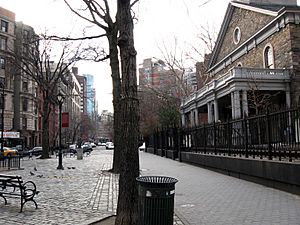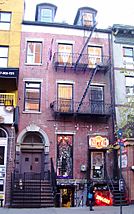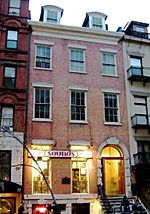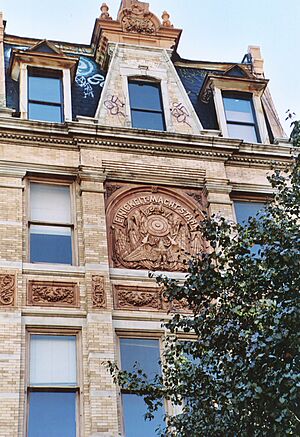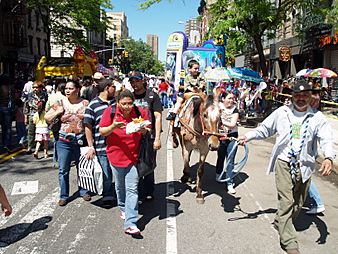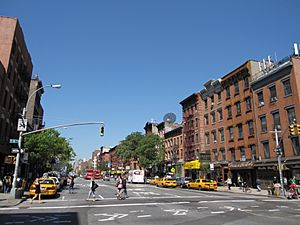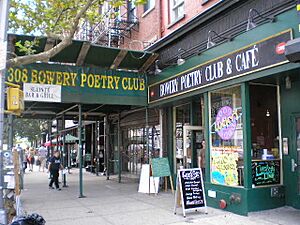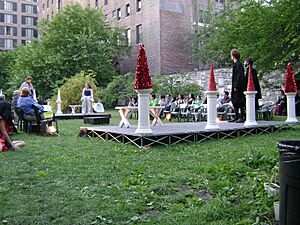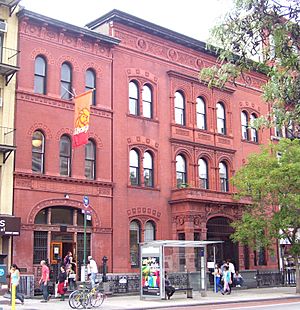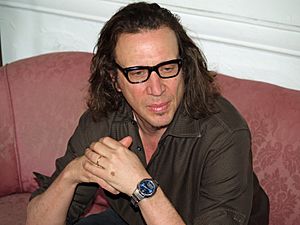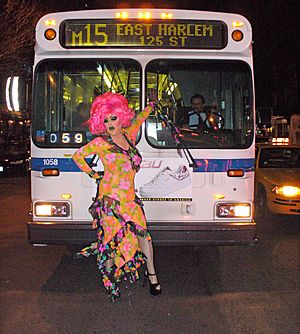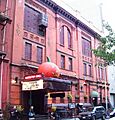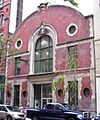East Village, Manhattan facts for kids
Quick facts for kids
East Village
|
|
|---|---|
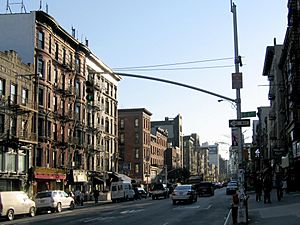
Second Avenue and 6th Street, facing south, photographed in 2005
|
|
| Country | |
| State | |
| City | New York City |
| Borough | Manhattan |
| Community District | Manhattan 3 |
| Named | 1960s |
| Area | |
| • Total | 1.8 km2 (0.68 sq mi) |
| Population
(2020)
|
|
| • Total | 71,436 |
| • Density | 40,560/km2 (105,100/sq mi) |
| Ethnicity | |
| • White | 48.9% |
| • Asian | 15.0% |
| • Hispanic | 23.7% |
| • Black | 7.6% |
| • Other | 4.9% |
| Economics | |
| • Median income | $74,265 |
| Time zone | UTC−5 (Eastern) |
| • Summer (DST) | UTC−4 (EDT) |
| ZIP Codes |
10003, 10009
|
| Area code(s) | 212, 332, 646, and 917 |
The East Village is a cool neighborhood in Lower Manhattan, New York City. It's on the east side of Manhattan, roughly between 14th Street to the north and Houston Street to the south. You can find it east of the Bowery and Third Avenue.
This area has a rich history! It was first home to the Lenape Native people. Later, Dutch settlers created farms here. In the 1800s, it became a fancy area with big estates. Then, many immigrants moved in, making it a lively place. For a while, it was even called "Little Germany" because so many German immigrants lived there.
In the 1960s, artists, musicians, students, and hippies started moving to the East Village. This gave the neighborhood its own special vibe and identity. Today, it's still a vibrant place, though it has changed quite a bit over the years.
The East Village is part of Manhattan Community District 3. Its main ZIP Codes are 10003 and 10009. The New York City Police Department's 9th Precinct keeps the area safe.
Unlike the West Village, the East Village is not part of Greenwich Village.
History of the East Village
How the East Village Began
The land where the East Village is today was originally home to the Lenape Native Americans. They moved around with the seasons, fishing by the shore in summer and hunting inland in fall and winter. In 1626, Peter Minuit bought Manhattan for the Dutch West India Company.
The Dutch colony of New Amsterdam was mostly south of what is now Fulton Street. North of that were large farms called bouwerij (which means "farm" in Dutch). Some of the earliest settlers in this area were free or "half-free" Africans who had their own communities around these farms.
One important farm belonged to Peter Stuyvesant, a leader of New Netherland. His family owned the land for over 200 years! Even after his manor burned down in the 1770s, his family kept selling off parts of the land in the early 1800s.
By the mid-1700s, many of these farms became rich country estates. The Stuyvesant, DeLancey, and Rutgers families owned most of the land in the Lower East Side, including what is now the East Village. City planners started mapping out streets in the late 1700s. The famous Commissioners' Plan of 1811 created the street grid we see today, though Stuyvesant Street is one of the few that doesn't quite fit the grid.
A Fancy Neighborhood
For a short time, the East Village was one of New York City's wealthiest areas. Streets like Bond Street were considered very fancy in the 1830s. This was partly because of the Erie Canal opening, which brought more business and people to the city.
Many beautiful rowhouses were built here in the 1830s. One block on 8th Street was even renamed "St. Mark's Place" and is still known by that name today. Developers also built houses near Tompkins Square Park, which was created in 1833.
Large mansions also appeared on Second Avenue. People even said Second Avenue would become one of the most elegant streets in Manhattan, like Fifth Avenue. Two private cemeteries, the New York City Marble Cemetery and the New York Marble Cemetery, were also built here.
A Neighborhood of Immigrants
The 1800s
By the mid-1800s, many wealthy families moved further uptown. Immigrants from Ireland, Germany, and Austria began moving into the rowhouses and mansions. The population grew very quickly, making it one of the most crowded parts of the city.
Because there weren't enough homes, many houses were divided into smaller apartments. New buildings called "tenements" were also built. These were often crowded, but laws were later passed to make them safer and healthier.
Many new immigrants were German speakers, so the East Village and Lower East Side became known as "Little Germany". It was a huge German community with clubs, churches, and even its own library. However, this community changed after a terrible boat accident in 1904, where many German-Americans died.
Other immigrant groups then moved in, including Italians, Eastern European Jews, Greeks, Hungarians, Poles, Romanians, Russians, and Ukrainians. Each group created its own small community.
The 1900s
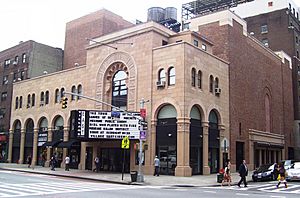
By the early 1900s, most of the old mansions on Second Avenue were replaced by apartment buildings. The New York State Tenement House Act of 1901 brought new rules for tenement buildings.
At the same time, the "Yiddish Theatre District" grew in the East Side. This area had many theaters and shows for Jewish immigrants. Second Avenue became a popular spot for Yiddish theater, with new theaters opening in the 1910s. After World War II, Yiddish theater became less popular.
In the mid-1900s, Ukrainians created a community around Second Avenue and 6th and 7th Streets. Other immigrant groups moved out, and their old churches became Orthodox cathedrals. Latin American immigrants also moved to the eastern part of the neighborhood, which became known as Loisaida.
The population of the East Side started to shrink in the 1930s. Many old tenements were torn down. A big plan to rebuild parts of the neighborhood was proposed in 1956, but it never happened because it would have forced many people to move.
New Identity and Art Scene
Becoming the East Village
Until the mid-1900s, this area was just the northern part of the Lower East Side. But in the 1950s and 1960s, artists, musicians, and writers began moving here. They were looking for more affordable places after Greenwich Village became too expensive. Famous writers like Allen Ginsberg and W. H. Auden moved here in the early 1950s.
Art galleries also started opening on East 10th Street. In 1955, the elevated train above the Bowery was removed, making the area more appealing. By 1960, people were calling the area "Village East" or "East Village" to give it a new, more artistic image. This new name became popular in the mid-1960s.
Growing as an Art Hub
The East Village became a center for counterculture and new art movements. It was important for punk rock and the Nuyorican literary movement. Many old Yiddish theaters became Off-Broadway show venues. East 4th Street, especially, became a hub for theater.
Even when the city faced tough times in the 1970s and 1980s, the East Village's music and art scenes thrived. Gay dance halls and punk rock clubs opened. Famous musicians like Bruce Springsteen and bands like Talking Heads played here. The Pyramid Club hosted bands like Nirvana and Red Hot Chili Peppers, and drag performers like RuPaul. By the mid-1980s, there were over a hundred art galleries.
Changes and Preservation
By 1987, many art galleries moved to other neighborhoods or closed. The success of the art scene had made the East Village more expensive. Today, some performance spaces still exist, like Sidewalk Cafe and poetry clubs like Bowery Poetry Club and Nuyorican Poets Café.
Local groups like the GVSHP work hard to protect the historic buildings and culture of the East Village. In 2012, parts of the East Village were officially named historic districts by the New York City Landmarks Preservation Commission. This helps save important buildings and the neighborhood's unique look.
Some famous buildings that are now landmarks include:
- The First Houses (1935), the country's first public housing.
- The Stuyvesant Polyclinic (1884).
- Public School 64 (1904–1906), a beautiful old school building.
- Webster Hall (1886), a concert hall and nightclub.
- The St. Nicholas of Myra Church (1886).
Unfortunately, some historic buildings have been lost despite efforts to save them.
Geography of the East Village
The East Village is next to the Lower East Side to the south, NoHo to the west, and Stuyvesant Town to the northeast. It has smaller, unique areas within it.
Neighborhood Sections
Alphabet City
Alphabet City is the eastern part of the East Village. It's called that because its avenues have single-letter names: A, B, C, and D. It runs from Houston Street to 14th Street. Important spots here include Tompkins Square Park and the Nuyorican Poets Café. St. Marks Place, a lively street, is also in Alphabet City.
Political Representation
The East Village is part of New York's 7th and 12th congressional districts. It's also represented in the state and city governments.
People of the East Village (Demographics)
The East Village had about 71,436 people living there in 2020. The neighborhood is quite diverse. About 48.9% of residents are White, 15.0% are Asian, 23.7% are Hispanic, and 7.6% are Black.
Most people in the East Village are adults. About 35% are between 25 and 44 years old. The average life expectancy here is 82.2 years, which is higher than the average for New York City.
The median household income in the East Village was $74,265 in 2017. About 18% of residents in the East Village and Lower East Side live in poverty.
Culture in the East Village
Hare Krishnas
On October 9, 1966, A.C. Bhaktivedanta Swami Prabhupada held the first outdoor chanting of the Hare Krishna mantra in the United States at Tompkins Square Park. This event is seen as the start of the Hare Krishna religion in America. A special tree in the park is marked as a religious site for followers.
Cultural Places
The East Village is full of cultural spots:
- Museums: Museum of Reclaimed Urban Space, The Ukrainian Museum.
- Movie Theaters: Anthology Film Archives, Village East Cinema.
- Music Venues: Bowery Ballroom, Mercury Lounge, Nublu Club.
- Poetry Venues: Nuyorican Poets Café, Bowery Poetry Club, Poetry Project at St. Mark's Church in-the-Bowery.
- Theaters and Performance Spaces: La MaMa E.T.C. (for experimental theater), Theater for the New City, and Stomp! (a long-running Off-Broadway show).
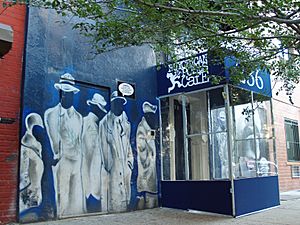
Neighborhood Festivals
The East Village hosts many fun festivals each year:
- Mayday Festival (May 1)
- Charlie Parker Jazz Festival (August)
- HOWL! Festival (Summer)
- Dance Parade (Summer)
- Dream Up Festival (August–September)
- Tompkins Square Halloween Dog Parade (October)
Parks and Gardens
Main Parks

Tompkins Square Park is a 10.5-acre public park in Alphabet City. It has a baseball field, basketball courts, playgrounds, and the city's first dog run. The park has been a site for many important events and protests throughout history. For example, in 1874 and 1877, large groups gathered there to protest. In 1988, there were clashes between police and protesters over a park curfew.
East River Park is a 57-acre park along the East River. It has fields for football, baseball, and soccer, plus courts for tennis, basketball, and handball. There's also a running track and bike paths, including the East River Greenway.
Community Gardens
The East Village and Lower East Side have many community gardens. These gardens are run by local groups and help keep the neighborhood green. They started appearing in the 1970s.
Open Road Park is a garden and playground next to East Side Community High School. The Avenue B and 6th Street Community Garden was once famous for its "Tower of Toys," a tall sculpture made of wooden planks and various objects. It was a neighborhood icon and even appeared in the TV show NYPD Blue. It was taken down in 2008 for safety reasons.
La Plaza Cultural de Armando Perez is a community garden and outdoor theater at 9th Street and Avenue C. It has been active since 1976.
Marble Cemeteries
The New York Marble Cemetery (1830) and the New York City Marble Cemetery (1831) are two of the oldest non-religious cemeteries in New York City. They are unique because many graves are underground vaults, not marked by traditional headstones. Famous people like U.S. President James Monroe are buried in the New York City Marble Cemetery.
Safety and Services
Fire Safety
The New York City Fire Department (FDNY) has four fire stations serving the East Village, ensuring quick response times for emergencies.
Post Offices
The East Village has three United States Postal Service post offices:
- Cooper Station
- Peter Stuyvesant Station
- Tompkins Square Station
Education in the East Village
The East Village has many college-educated residents. About 48% of adults have a college degree or higher. Students in the East Village and Lower East Side generally do well in school.
Schools
The New York City Department of Education runs public schools in the East Village. Students can apply to any school in Community School District 1.
Some elementary schools include:
- PS 15 Roberto Clemente
- PS 19 Asher Levy
- PS 34 Franklin D Roosevelt
- The Earth School
Middle and high schools include:
- East Side Community High School (grades 6–12)
- Tompkins Square Middle School (grades 6–8)
There are also independent schools like The New Amsterdam School.
Libraries
The New York Public Library (NYPL) has three branches near the East Village:
- The Ottendorfer branch (1884) is a historic building.
- The Tompkins Square branch (1887).
- The Hamilton Fish Park branch (1960).
Colleges
New York University
New York University (NYU) has many buildings in the East Village, including dorms for students. This has sometimes caused disagreements between the university and local residents who want to preserve the neighborhood's historic feel. For example, St. Ann's Church was sold to NYU for a new dorm, and while the church's facade was saved, the new building is the tallest in the area.
Cooper Union
The Cooper Union for the Advancement of Science and Art is a famous college founded in 1859. It's known for its programs in engineering, art, and architecture. Its Great Hall has hosted many important speeches, including one by Abraham Lincoln.
Transportation
The East Village is served by several New York City Subway stations, including Second Avenue, Astor Place, Eighth Street–New York University, and First Avenue. There are also many bus routes that go through the area.
Media
The East Village has its own local news sources, like East Village Feed and The East Villager. It also has a local radio station, East Village Radio.
Notable Residents
Many famous people have lived in the East Village, including:
- Ryan Adams – musician
- Darren Aronofsky – filmmaker
- W. H. Auden – poet
- Jean-Michel Basquiat – artist
- William S. Burroughs – novelist
- Julian Casablancas – musician
- Christian Cooper – science writer
- David Cross – actor, comedian
- Quentin Crisp – writer
- Rosario Dawson – actress
- Lady Gaga – singer
- Allen Ginsberg – poet
- Philip Glass – composer
- Nan Goldin – photographer
- Keith Haring – artist
- Richard Hell – musician, author
- Abbie Hoffman – political activist
- Harold Hunter – skateboarder, actor
- Sarah Hyland – actress
- Jim Jarmusch – film director
- Jonathan Larson – composer of Rent
- John Leguizamo – actor, comedian
- Madonna – singer (in the 1980s)
- Conor Oberst – musician
- Claes Oldenburg – sculptor
- Iggy Pop – musician
- Daniel Radcliffe – actor
- Joey Ramone – musician
- Johnny Ramone – musician
- Lou Reed – musician
- Mark Ronson – musician
- Jerry Rubin – political activist
- Liev Schreiber – actor
- David Schwimmer – actor
- Chloë Sevigny – actress
- Sam Shepard – playwright, actor
- Kiki Smith – sculptor
- Regina Spektor – singer–songwriter
- Frank Stella – painter
- Ellen Stewart – founder of La MaMa, E.T.C.
- Marisa Tomei – actress
- Rachel Weisz – actress
- John Zorn – musician
Images for kids
See also
 In Spanish: East Village para niños
In Spanish: East Village para niños


